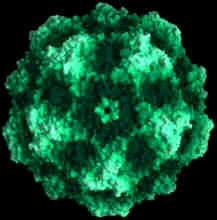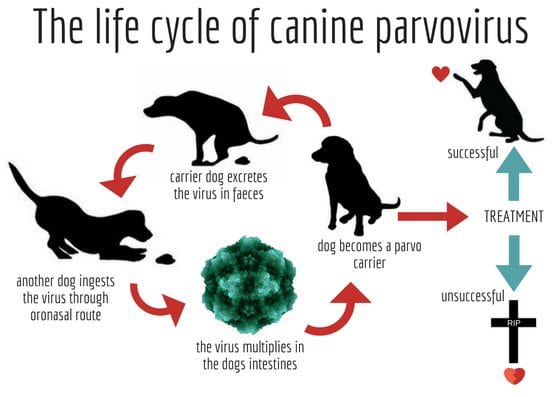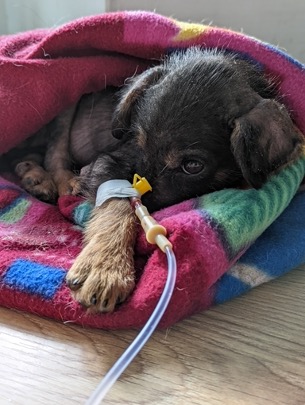Dogs are susceptible to a variety of infectious diseases, such as parvo, distemper, the dreaded rabies, and kennel cough, to name just a few.
Join us as we explore some of the most common infectious disease that dogs can suffer from. Find out how the disease is transmitted, what symptoms to watch out for, how it is treated, and most importantly how to protect your dog from getting ill in the first place.
Each of the next few blog posts will discuss a different infection… this week… its parvo.
What is parvo?
The parvo we usually refer to is a form of haemorrhagic gastroenteritis that is caused by canine parvovirus-2 (CPV2). However, there are other parvoviruses that affect different animals and very rarely CPV2 can cause cardiac symptoms if it infects newborn puppies.
Infection with the parvo virus can result in the death of a young puppy in 2 to 3 days if untreated, and even with aggressive treatment, some puppies sadly succumb to this virus because of the severity of its effects on the body

How do dogs become infected with the parvo virus?
Dogs love to smell and lick things in their environment… it’s how they explore the world. Unfortunately, sometimes they ingest the poop of other dogs that may be contaminated with the parvo virus. Or they may lick something, even their own paws, that has come into contact with parvo infected poop. Once ingested, the virus targets the cells of the intestine and rapidly multiplies.
After exposure, the incubation period is approximately 7 days until the onset of symptoms.

What are the symptoms of parvo?
Symptoms are quite non-specific, and on their own can be symptoms of other illnesses. Therefore, any symptoms should be assessed in combination with exposure risk, vaccination history (or lack of), and age of the dog.
Symptoms include:
lethargy, not eating, vomiting, severe diarrhoea (often with blood present), fever.
Usually the first sign is not eating, followed by vomiting after drinking water, then diarrhoea that gets progressively worse.

How is parvo treated?
There is no miracle cure for parvo, so the treatment involves providing supportive care until the immune system fights off the virus. This includes:
Fluid therapy to prevent dehydration caused by vomiting and diarrhoea. This is one of the most important treatments as puppies can become dangerously dehydrated very quickly.
Antibiotics to prevent secondary bacterial infections caused by the breakdown of the intestinal lining. The virus causes damage to the intestinal lining and prevents new intestinal cells from being produced. This allows bacteria to pass into the blood stream and prevents nutrients from being absorbed,
Medicine to help minimise vomiting (anti-emetics) and reduce stomach acidity.
Medicine to help clear up the diarrhoea
Other supportive drugs to minimise the symptoms and make the puppy comfortable.

Puppies should receive fluids based on their body weight, level of dehydration, and electrolyte imbalances.
Can my puppy pass the parvo to other dogs after it has recovered?
Yes! After recovery, a puppy sheds the virus in its stool for approx. two weeks, which spreads the virus to other vulnerable dogs and puppies.
To make matters worse, the parvo virus is very stable and remains viable in the environment for up to six months in optimal conditions. The virus can even withstand the effects of heat, alcohol, disinfectants, and detergents. Therefore, it is extremely difficult to clean an area and make it parvo-free.
This means that even if you remove the poop of a dog that has recently recovered from parvo, the virus will still be on the ground, just waiting for the next dog to come sniffing around.
A diluted bleach solution is one of the only substances that is able to kill the virus. But it should be made up to a 1 in 30 dilution and applied to floors, surfaces, bowls, etc for 10 to 15 minutes before thoroughly rinsing off.
Although parvo primarily affects young puppies, adults that have not been vaccinated can be susceptible to the disease, and can still contract and spread the virus.
In addition, certain breeds of dog are far more severely affected if they become infected. These include:
Rottweilers, German Shepherds, Doberman Pinschers, Labrador Retrievers, Bull Terrier breeds, and Alaskan sled dogs (Huskies, Alaskan malamutes, Samoyeds) (another great reason to rescue/adopt mix breed dogs/street dogs).
How do I protect my puppy/dog from contracting the parvo virus?
Parvo is everywhere in the environment. It can be transferred from outside on your shoes, clothing, bags; from one dog to another via their poop, eating or drinking from bowls of infected dogs; sharing toys, etc.
Therefore, it is impossible to prevent your dog from coming into contact with the virus. So, to minimise the risk of your pet and any other dogs from being affected by the virus it is vital to vaccinate them. This will improve your pet’s immunity to the parvo virus so when it is exposed, your pet’s immune system has a better chance of fighting it off before causing illness.

The DHPPi vaccine (also known as 5-in-1 or 6-in-1 if leptospirosis is included) covers the following infections:
- canine parvovirus (CPV),
- canine distemper virus (CDV),
- canine infectious hepatitis caused by canine adenovirus type 1 CAV1),
- respiratory infections (kennel cough) caused by canine parainfluenza (CPi) and canine adenovirus type 2 (CAV2).
When should I get my puppy/dog vaccinated?
The vaccine schedule for puppies is as follows:
6–8 weeks – core vaccines against parvo, distemper, hepatitis and respiratory infections (DHPPi)
10–12 weeks – Booster for core vaccines
It is usually recommended to give a 2nd booster at 16–18 weeks old (and even a 3rd in some instances). This is because if the puppy’s mother had immunity to the diseases it is being vaccinated against, the mother will have passed on antibodies against those diseases. These antibodies interfere with the vaccine, preventing it from working properly. Therefore, it is important to give a vaccine after the mother’s antibodies have worn off.
12 weeks – anti-rabies vaccine
16 weeks – anti-rabies booster,
Then yearly anti-rabies boosters (depending on location and rabies burden).
We hope we have given you the basic information needed to make the right decision and get your dog vaccinated against parvo.
In addition, if you live in an area with free-roaming dogs, you can help out pet owners, animal rescue charities, and of course the street dogs themselves by getting any puppies born in your area vaccinated too.
But above all, remember, if your dog is sick, not eating, vomiting, or has diarrhoea, please take it to see a vet. Do not attempt to self-diagnose and treat at home. If the puppy does have parvo, a few electrolyte solutions won’t be enough to support your dog through something like parvo.
Join us next time when we will tell you tall about canine distemper.
